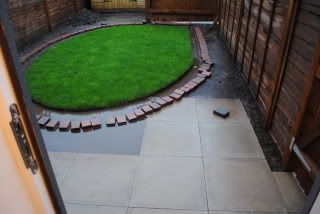Posted: Mon Feb 14, 2011 11:54 am
Hi all,
I have a minor drainage problem in my back garden, close to the house. The house is brand new and soil is heavy clay type. Garden is approx 4m wide x 7m long. It has a slight downwards slope towards the house though it flattens out towards the rear. There's no obvious end point for a french drain.
Adjoining the back of the house are two rows of 60cm paving slabs, followed by 60-120cm of bare soil, then a circular lawn.
When it rains heavily the soil area between the lawn and slabs puddles and if exceptionally wet these puddles spread onto the paving slabs but don't reach the house. The majority of the puddles soak away within a few hours but at it's worst the small area looks pretty flooded. The lawn doesn't suffer these problems.
I'm planning on putting gravel down in the area between the circular lawn and the row of paving, where the pooling happens to be worst. I'm looking at digging down the depth of a kerb and filling it with gravel with potentially some kind of sub base.
The plan is the gravel sits nicely around the bottom end of the curved lawn and the trench it sits in acts a bit like a shallow soakaway, holding any puddles beneath the surface while it soaks into the soil.
Couple of questions:
A: is this likely to work. I don't think the drainage problem too bad and not having any grass in that area seems to highlght the issue.
B: What's a good porous subbase for beneath the gravel? Or should I just use loads of gravel? It's not a big area to fill but will be walked on a fair bit.
Sorry, this was a bit long-winded. Thanks for any info.
I have a minor drainage problem in my back garden, close to the house. The house is brand new and soil is heavy clay type. Garden is approx 4m wide x 7m long. It has a slight downwards slope towards the house though it flattens out towards the rear. There's no obvious end point for a french drain.
Adjoining the back of the house are two rows of 60cm paving slabs, followed by 60-120cm of bare soil, then a circular lawn.
When it rains heavily the soil area between the lawn and slabs puddles and if exceptionally wet these puddles spread onto the paving slabs but don't reach the house. The majority of the puddles soak away within a few hours but at it's worst the small area looks pretty flooded. The lawn doesn't suffer these problems.
I'm planning on putting gravel down in the area between the circular lawn and the row of paving, where the pooling happens to be worst. I'm looking at digging down the depth of a kerb and filling it with gravel with potentially some kind of sub base.
The plan is the gravel sits nicely around the bottom end of the curved lawn and the trench it sits in acts a bit like a shallow soakaway, holding any puddles beneath the surface while it soaks into the soil.
Couple of questions:
A: is this likely to work. I don't think the drainage problem too bad and not having any grass in that area seems to highlght the issue.
B: What's a good porous subbase for beneath the gravel? Or should I just use loads of gravel? It's not a big area to fill but will be walked on a fair bit.
Sorry, this was a bit long-winded. Thanks for any info.

